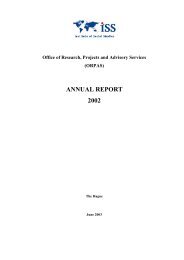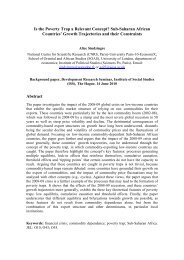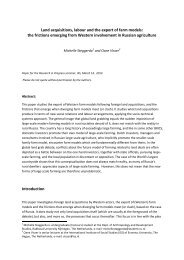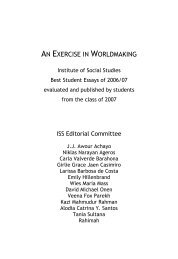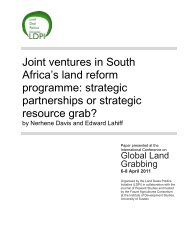AN EXERCISE IN WORLDMAKING 2009 - ISS
AN EXERCISE IN WORLDMAKING 2009 - ISS
AN EXERCISE IN WORLDMAKING 2009 - ISS
Create successful ePaper yourself
Turn your PDF publications into a flip-book with our unique Google optimized e-Paper software.
18 <strong>AN</strong>DREA NICOLE DYKSHOORN<br />
ple, is a relatively new initiative called “Settlement Workers in Schools”<br />
(SWS), which is expanding in several provinces through government<br />
funding. This programme matches trained workers with specific language<br />
skills—and often coming from similar cultural backgrounds—to<br />
immigrant and refugee students. Various other examples exist as evidence<br />
that the school systems are working to provide support to diverse<br />
populations.<br />
It is also important to recognise that the way in which schools assess<br />
and address the needs of refugee students differs greatly between individual<br />
schools, districts, and provinces. While the curriculum and funding<br />
are determined at the provincial level, districts and schools make decisions<br />
about the types of programmes that will be offered, as well as the<br />
allocation of financial and other resources to these programmes. Yet despite<br />
these differences, studies reveal that refugee students in metropolitan<br />
Toronto (Yau, 1995) experience many of the same barriers as those<br />
studying in rural and urban Manitoba—a province with considerably<br />
fewer resources devoted to immigrant and refugee programmes in<br />
schools (Kanu, 2008). If left unaddressed, these barriers have the potential<br />
to significantly and negatively affect the integration process for refugee<br />
students—and this will have consequences for society as a whole.<br />
1. Placement<br />
One of the first challenges facing the Canadian education system is the<br />
placement of refugee students. In numerous Canadian studies, refugee<br />
students themselves have identified improper grade placement as a significant<br />
barrier to their educational experience. According to research<br />
done by Kaprellian-Churchill (1996: 354), students of primary school age<br />
are generally placed in classes with their same age cohort. Yet at the secondary<br />
school level, age placements can lead to high levels of frustration<br />
and disillusionment, thereby increasing the likelihood of students dropping<br />
out. This was precisely the concern voiced by Sudanese refugee students<br />
in a recent needs assessment conducted by the African Sudanese<br />
Association of Calgary (ASAC, <strong>2009</strong>: 26). In another study of refugee<br />
students, this time in Manitoba, a teenager of an African background reported<br />
the following frustrations at the placement practices of the<br />
school:




